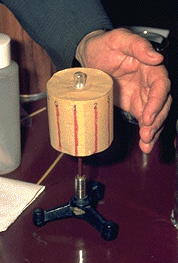That Spinning Cylinder
Preface
Hope you liked my report on Time Travel ;-) No doubt that piece has made you skeptical of anything I might have to say! That's good, because here comes a no-foolin' honest observation that's puzzled me for years, and I'd really appreciate some skeptical, thoughtful analysis.
Origin
 I first encountered the cylinder in Prague in 1973. Its proponent Krmessky presented a paper and demonstrated it on the stage. It appeared to be nothing more than a cylinder constructed of paper, open at the bottom, suspended from a low-friction bearing in the center of the flat face. The bearing stood on a little tripod, so the cylinder could rotate freely. The sides of the cylinder had vertical markings to make its rotation easily apparent.
I first encountered the cylinder in Prague in 1973. Its proponent Krmessky presented a paper and demonstrated it on the stage. It appeared to be nothing more than a cylinder constructed of paper, open at the bottom, suspended from a low-friction bearing in the center of the flat face. The bearing stood on a little tripod, so the cylinder could rotate freely. The sides of the cylinder had vertical markings to make its rotation easily apparent.
Krmessky placed his hands along the sides, curling his fingers slightly to follow the cylinder's curve, yet not touching it. He then demonstrated, as far as the unaided eye could tell, that he could cause the cylinder to rotate in either direction.
He also demonstrated this apparent telekinesis with a few other devices. I remember an object that floated in a pan of water; he could make it come toward his hands and move away from them.
A skilled magician could, no doubt, find numerous ways to achieve such effects. However, after the presentation, Krmessky left it all on the table, so anyone could examine and try out this and other toys. To my surprise, I was able to make the cylinder move!
Independent Verification
Although I wasn't as skeptical then as I am today, I recognized that the conditions at the conference were unusual. Upon my return home, I constructed a similar device, a cylinder of ordinary writing paper approximately three inches (about 8 cm) in diameter and about four inches (about 10 cm) tall. I drew some vertical lines on the sides to make motion easier to see. For the bearing, I inserted a miniature glass test tube through a hole in the top and set the tube atop a needle driven into the eraser of a pencil. I set the pencil in some sort of base to hold it vertical.
It worked! I was able to make it spin, slowly at first, then ever faster. The acceleration seemed to correspond to how hard I was "trying." I could start it spinning one way and then concentrate on turning it the other way, and it would slow down, stop, and begin to accelerate in the other direction. If I didn't consciously will it to rotate, it wouldn't move.
Uncertainty
This was over two decades ago, and my memory isn't clear on a few points. I know I could make it move with only one hand, but I'm not sure whether I could move it either way with the same hand. I'm not sure I could move it with both hands near it. I do know I made considerable effort to shield the cylinder from my own breathing or any air currents I noticed.
Quest
The obvious answer is to try it again. When I do, I'll publish the results here.
However, even if I demonstrate that I can do it again, who would believe it? Well, that's the wrong question--lots of folks believed Uri Geller! Seriously, if you simply watch me doing it, it proves nothing. I'd like other people to try this and assure themselves it can be done. More importantly, I'd like someone to give me an explanation that's verifiable.
If you have had similar experiences, or if you have some explanation for this phenomenon, please let me know! Send me an email at [email protected] or use the form:
Ted Ruegsegger
[email protected]
 I first encountered the cylinder in Prague in 1973. Its proponent Krmessky presented a paper and demonstrated it on the stage. It appeared to be nothing more than a cylinder constructed of paper, open at the bottom, suspended from a low-friction bearing in the center of the flat face. The bearing stood on a little tripod, so the cylinder could rotate freely. The sides of the cylinder had vertical markings to make its rotation easily apparent.
I first encountered the cylinder in Prague in 1973. Its proponent Krmessky presented a paper and demonstrated it on the stage. It appeared to be nothing more than a cylinder constructed of paper, open at the bottom, suspended from a low-friction bearing in the center of the flat face. The bearing stood on a little tripod, so the cylinder could rotate freely. The sides of the cylinder had vertical markings to make its rotation easily apparent.